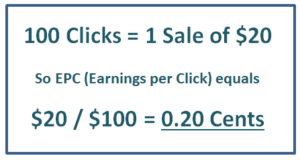Understanding EPC – 1 Click, 100 Clicks or 1000 Clicks?
With so many terms and variations used in performance marketing there continues to be confusion in the space. With metrics measuring ROAS, CRM, CTR, CPC, PPC and so many more, the terms used to describe EPC in affiliate marketing, or Earnings Per Click, is no exception.

EPC is one of the most important metrics both for affiliates and affiliate managers alike . It helps understand the success rate of an affiliate program over a particular timeframe compared to other programs, helps affiliates understand how much they may earn and if a program is well managed, and helps merchants understand how well their affiliates are performing and what they may potentially be doing to drive sales.
Variables that affect EPC are things like cookie days, website conversion rates, commission payouts, the quality and quantity of affiliates driving clicks to a program, how they are driving those clicks and more.
But the confusion comes in more so by the variances in EPC definition. Some networks, such as Google Affiliate Network, use a 100 click EPC benchmark to describe the average earnings, and others, such as Commission Junction, describe it as the average earnings for every 1000 clicks.
Further, some affiliates break it down themselves to understand what they might earn per one click. This is generally the case with PPC affiliates who have to measure true EPC to determine Net Earnings Per Click which are calculated, not on gross sales, but on RPC (Revenue Per Click) minus CPC (Cost Per Click).
eFax.com has an interesting description of EPC to clarify further:
“Your EPC (Average Earnings Per One Hundred Clicks) is a relative rating that illustrates the ability to convert clicks into commissions. Your EPC is calculated in an “apples to apples” comparison with all publishers by taking each publisher’s total commissions earned (regardless of currency) and then converting that total (if necessary) to US dollars.”
Commission Junction also breaks it down well based on their internal processes:
“Three month EPC values are calculated and updated daily, using data beginning five months previous through three months previous. On the first of each month the “five months previous through three months previous” timeframe changes to accommodate the month change. For example, an EPC rating in June is calculated using data from January, February, and March. It is necessary to use data beginning five months previous to give accurate EPC ratings that may include extended or reversed transactions.
There must be at least 1000 clicks for the 3-month period to calculate your EPC. If less than 1000 clicks occurred, N/A will display for the EPC.
7 day EPC is a calculation made by taking data from yesterday counting back seven days. We take the sum of all commissions for the 7 days and divide it by the sum of all clicks for the same 7 days then multiplying this by 100. If today’s date = N, the date range used is N-8 to N-2. NOTE: There must be at least 100 clicks for the 7-day period to calculate your EPC.
In the words of Carolyn Kmet, the point of this exercise is to understand that EPC should be used to determine if a merchant is converting or not and how it’s performing in relation to other programs.
If an affiliate is calculating their own EPC, they need to use whichever calculation makes the most sense for them. For many, EPC is more of a standardized approach to gauging whether or not a program converts over time, rather than an end-all-be-all in determining exact financial earnings.
